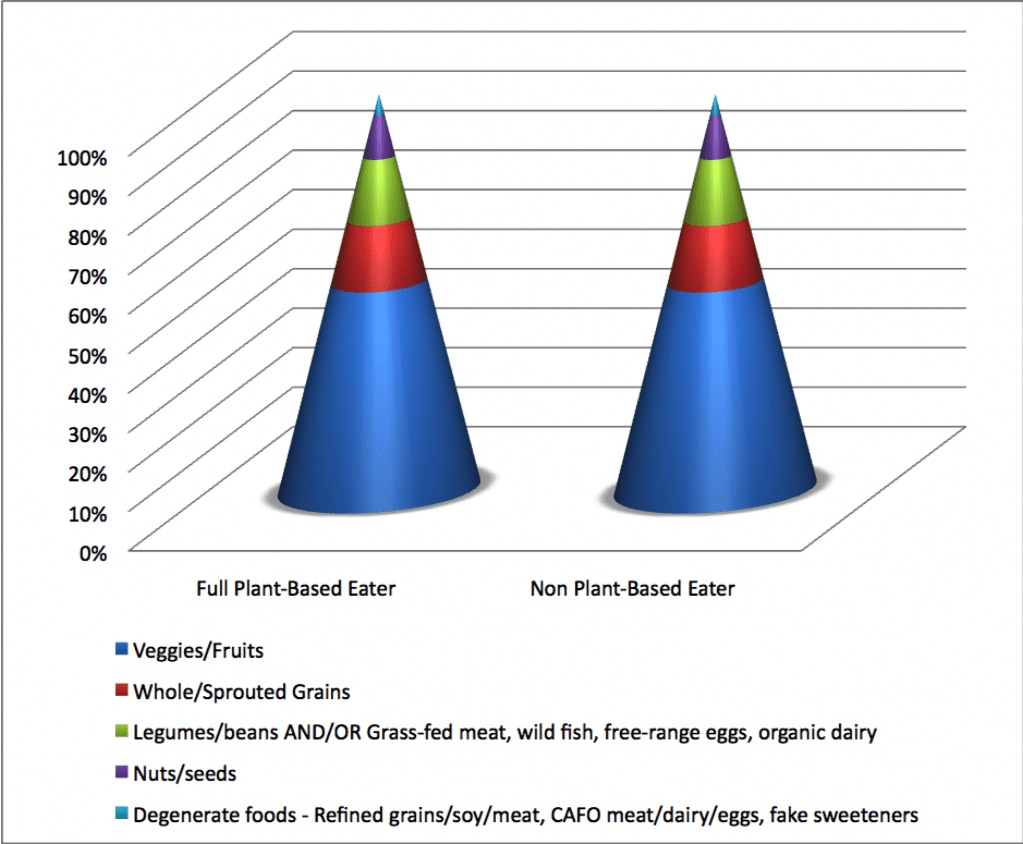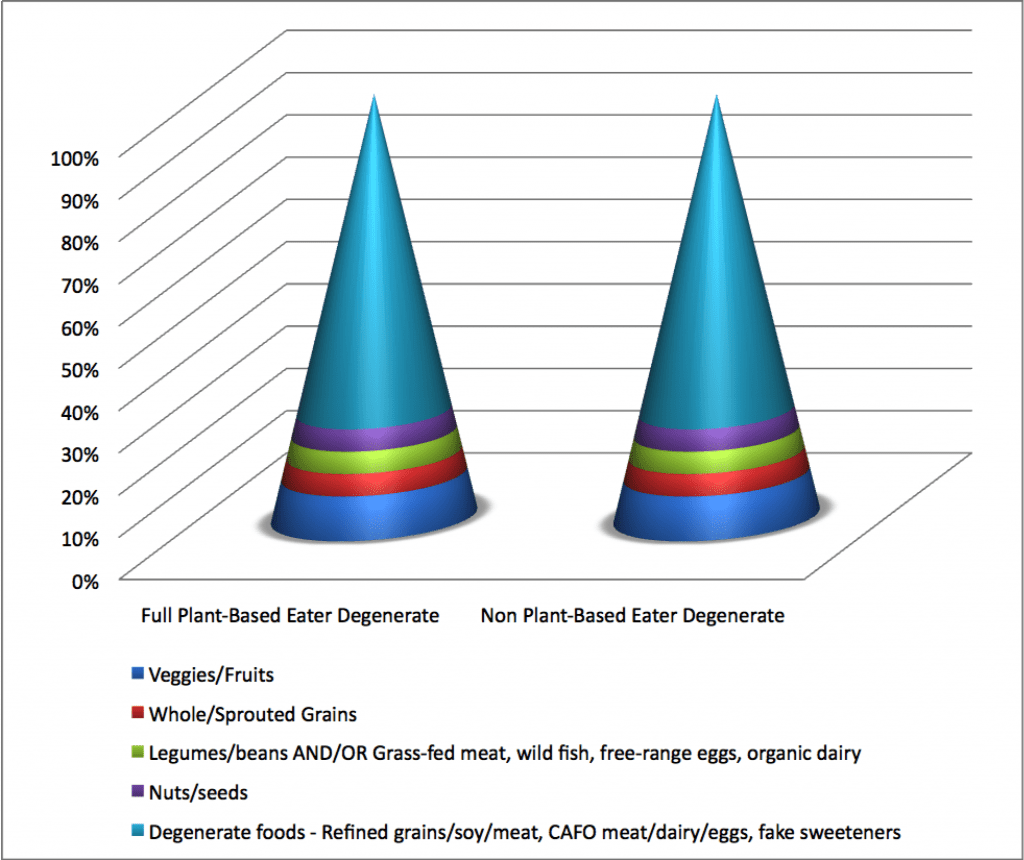It doesn’t matter if you are “Paleo Person,” “Veg Guru,” or “Flexitarian.” If you’re healthy, fit and lean — and have been for a while — I bet you eat much like I do.
Talking to different eaters would lead you to believe otherwise. Various “eating groups” claim their diet is drastically different and drastically better than others.
I think everyone is missing the point:
Healthy eating styles have more similarities than differences.
Most healthy styles of eating that exist today really aren’t much different at all.
Set out a day’s worth of food for any healthy and fit person, and here’s what you’ll probably see.

The difference is small.
Only about 15% of the food type is different (the green category). That’s it!
So, about 85% of the time healthy eaters consume the same foods.
The magic 5%
Where all groups of eaters go wrong is with the 5% category, better known as “degenerate foods.”
It’s at the top — light blue. You can barely see it in the chart above. This is where we all make or break our nutrition.
We’re all familiar with degenerate food. It’s the pathetic stuff – refined grains/soy/meat, factory farmed meat/dairy/eggs, artificial sweeteners, etc.
Here’s a “degenerate diet”.

See the difference?
It’s not that one group is eating a few more ounces of grass-fed beef, an extra free-range egg, or more cubes of tofu. Both groups go wrong with the degenerate foods.
When these foods start to comprise a big chunk of daily intake, our next stop is fat/disease town.
If your goal is Paleo eating, lean & green eating, full plant-based eating, flexitarian eating, or something in between, then the only difference lies in that 15%. It comes down to swapping meat/eggs/dairy for more legumes/beans. Simple deal.
“Meat to bean” swap
Now, let’s say someone is going to make the “meat to bean” food swap, and 85% of their diet is already in great shape. Let’s see what happens.
8 ounces of grass-fed beef, 1 cup of 2% Greek yogurt, 2 eggs
— exchanged with —
2 cups of sorted legumes/beans/peas
Here comes the drama. This type of swap freaks people out.
The #1 concern I hear from people is that swapping meat/eggs/dairy for legumes will result in too many carbs. To them this means more body fat. Don’t act like you haven’t heard it. We all have.
Let’s step back and examine this.
8 ounces of grass-fed beef, 1 cup of organic 2% Greek yogurt, 2 free-range eggs
This provides about:
770 calories
38 grams of fat
11 grams of carbohydrates
0 grams of fibre
92 grams of protein
2 cups of sorted legumes/beans/peas
This provides about:
440 calories
2 grams of fat
79 grams of carbohydrates
31 grams of fibre
32 grams of protein
Net change with the legumes/beans:
330 fewer calories
36 fewer grams of fat
68 more grams of carbs
31 more grams of fibre
60 fewer grams of protein
330 fewer calories each day is a big drop in energy.
31 more grams of fiber and 330 fewer calories leaves me thinking about two things:
1. More bowel movements
2. Less body fat
So, while many people fear that a legume swap will cause fat gain, don’t sweat it. Just focus on learning how to prepare your legumes so that you’ll minimize anti-nutrients. (For example, rinse then soak them for several hours, changing the water occasionally, before cooking.)
Food substitution per se doesn’t lead to fat gain, if that food substitution is with other whole foods.
Here’s what does cause fat gain
When the 8 ounces of grass-fed beef, 1 cup of organic 2% Greek yogurt, and 2 free-range eggs are swapped for copious amounts of processed foods. For example:
Many plant-based eaters remove the animal protein… but don’t replace it with anything useful. They simply increase their proportion of processed junk: fake meats, rice cakes, “whole-grain” crackers, soy cheese, organic candy, etc.
Many Paleo eaters remove the grains… but assume that anything meat- or nut-based is OK. They replace grains with processed junk: beef jerky, deli turkey, and commercial nut butter. They might overdose on juice or commercially dried fruit because hey, that’s fruit, right?
Many flexitarians just figure as long as they eat broccoli, they earned that cookie. Hey! Processed junk again!
And many folks don’t even bother with thoughtful portion control. They assume that if they’re eating the “right” foods for their special, unique diet, their appetite and eating habits will magically be perfect.
Let’s compare some processed foods available to each group.
Protein from organic whole soybeans and soy isolate, organic brown rice syrup, maltitol syrup, chocolate chips [sugar, unsweetened chocolate, cocoa butter, vanilla beans, soya lecithin (added as an emulsifier)], peanut flour, peanuts, xylitol, natural flavors, salt and soya lecithin.
Maltitol syrup, rice protein concentrate, erythritol, almond butter, unsweetened chocolate, glycerine, digestion resistant fiber (fibersol 2) crisped rice (rice flour, malt extract, rice bran, calcium carbonate), guar gum, coconut oil, cocoa powder, natural peanut butter, creatine magnapower (magnesium creatine chelate), natural flavour, Rice X stabillized rice bran, sea salt, alpha lipoic acid, chromium niacin glycine chelate.
Chocolatey coating (sugar, fractionated palm kernel oil, cocoa powder, whey powder, skim milk powder, soy lecithin, vanilla), caramel (corn syrup, sugar, cream, water, fructose, palm oil, soy lecithin, salt, sodium phosphate, flavour, carrageenan), corn syrup, Trisource (™) protein blend (whey protein Isolate, calcium caseinate, soy protein isolate), maltitol syrup, glycerine (vegetable source), oat fibre, soy crisps (soy protein isolate, tapioca starch, salt), peanuts, high oleic canola oil, cocoa powder, almond butter, flavour, soy lecithin, salt, peanut flour, vitamins and minerals: ascorbic acid (vit c), niacinamide (vit b3), dl-a;pha-tocopherol acetate, calcium pantothenate, pyridoxine hydrocloride (vit b6), riboflavin (vit b2), thiamine mononitrate (vit b1), vitamin a palmitate, folic acid, biotin, cholecalciferol (vit D), cyanocobalamin (vit b12), potassium phosphate, calcium carbonate, calcium phosphate, magnesium oxide, ferrous fumarate (Iron), zinc oxide, manganese sulfate, copper gluconate, potassium Iodide.
Oh dear.
Where do we all go wrong with nutrition? The degenerate foods. This includes Paleo eaters and vegans alike.
Feel free to play around with the 15% category – it’s quite small. The other 85% will make or break you.
Learn more
Want to get in the best shape of your life, and stay that way for good? Check out the following 5-day body transformation courses.
The best part? They're totally free.
To check out the free courses, just click one of the links below.




Share